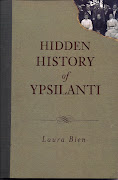Regular readers know that avid driver Carrie Hardy, as one reader noted, "certainly gets around." She took one of many trips to Ann Arbor last week. DD assumed this was just up Washtenaw. DD was probably totally wrong. The 1913 King's Official Route Guide stresses that the best route from Ypsilanti to Ann Arbor was NOT via Washtenaw, but by a more northern route that was "mostly gravel." When DD learned that, she remembered that, at least from the Stadium split up into Ann Arbor, Washtenaw was a dirt road. It may have been dirt its entire length in Carrie's day--full of rocks, potholes, mud, washboard sections, and interminable choking dust.
 Many Ypsi roads at the time were dirt--in fact, in July of 1919, just as we read of Carrie tooling around, the Ypsilanti City Council was all in a swidget about oiling the city roads.
Many Ypsi roads at the time were dirt--in fact, in July of 1919, just as we read of Carrie tooling around, the Ypsilanti City Council was all in a swidget about oiling the city roads. There was talk of one Alderman oiling the road he lived on as other roads remained unoiled.
The oiling-men were accused of failing to oil streets in "the Negro district."
Oiling roads consisted of applying oil to dirt roads to tamp down the flying dust and dirt and make the road firmer.
For the July 7, 1919 Council meeting, "OILING OF STREETS THE MOST IMPORTANT QUESTION AT PRESENT," noted a July 10 Ypsilanti Record article, at left.
Carrie didn't bother with the troublesome dirt roads on her jaunt to Ann Arbor--if she followed King's recommended route. Let's retrace it with her. Hop in!

 The route starts at Huron and Michigan Ave. (Congress).
The route starts at Huron and Michigan Ave. (Congress). The guide points out the Masonic Temple (Riverside Arts Center) and the Ladies' Library on the right as landmarks.
After the curve, Huron's brick pavement ends at Cross Street, and Huron turns into a gravel road. You can see a legacy of Huron's brick paving just south of City Hall, on the east side of Huron. There's about 30 feet of brick-paved sidewalk still there.
Next landmarks are the Gas Company on the northeast side of Huron and Forest, and the city's forgotten second Freighthouse, this one not the familiar one near Depot Town once belonging to the Michigan Central Railroad company but one belonging to the Lake Shore & Michigan Southern railroad company.

.jpg) The next step is to cross the LS&MS tracks (but not the MCRR's) and continue past a mysterious "Standard Oil Tank," which is not depicted on this 1915 plat map.
The next step is to cross the LS&MS tracks (but not the MCRR's) and continue past a mysterious "Standard Oil Tank," which is not depicted on this 1915 plat map.A bit further, one passes the Peninsular Paper Mill, now demolished with the Peninsular Apartments in its place on the west side of LeForge (and another part of the apt. complex on the east).
The road begins to dip down as it does today near Superior Road. It follows Huron River Dr. to Old Dixboro Rd. For the last bit of our journey, we hop over to Ann Arbor Township.

 The route turns onto Old Dixboro Road and goes downhill to a "dangerous R. R. at Geddes." Likely the train here was more dangerous than the previous LS&MS crossing because it is traveling fast between cities, and not slowed down to drop off and pick up passengers and freight. It is also interesting to note, if you glance at the river to the west, that there are no big lakes in Gallup Park--presumably the Dixboro dam was not yet built.
The route turns onto Old Dixboro Road and goes downhill to a "dangerous R. R. at Geddes." Likely the train here was more dangerous than the previous LS&MS crossing because it is traveling fast between cities, and not slowed down to drop off and pick up passengers and freight. It is also interesting to note, if you glance at the river to the west, that there are no big lakes in Gallup Park--presumably the Dixboro dam was not yet built.Up the hill, we arrive at Geddes and turn left, where there's a little school, now erased by US-23. If the school wasn't moved, perhaps there's a page or two of a McGuffey Reader or an arithmetic book far beneath the freeway concrete, from the vanished schoolhouse.
After crossing the bridge on Fuller (now near the public pool), we are in sight of the U-M buildings and the journey ends with a turn onto Wall Street and then Broadway. And we're there!
King's recommended route from Ann Arbor to Ypsi is the same in reverse, and there are no other routes listed that the guide recommends--neither Washtenaw nor Packard. Clearly, this was the best route, and most likely the one Carrie took on her trips to Ann Arbor. Thank you for coming along for this one!



















































